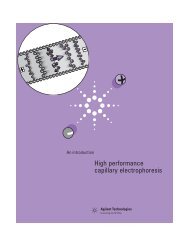Using ChemStation Plus and Agilent column ID tags for easier ...
Using ChemStation Plus and Agilent column ID tags for easier ...
Using ChemStation Plus and Agilent column ID tags for easier ...
Create successful ePaper yourself
Turn your PDF publications into a flip-book with our unique Google optimized e-Paper software.
<strong>Using</strong> <strong>ChemStation</strong> <strong>Plus</strong> <strong>and</strong><strong>Agilent</strong> <strong>column</strong> <strong>ID</strong> <strong>tags</strong> <strong>for</strong> <strong>easier</strong>h<strong>and</strong>ling <strong>and</strong> compliance inregulated laboratoriesApplication NoteIntroductionAll laboratories have some sortof repository such as a drawer orcupboard, which are full of<strong>column</strong>s. These <strong>column</strong>s are usuallystored with little or no documentationabout the state of the<strong>column</strong>, <strong>for</strong> example, if the <strong>column</strong>is still good, or how much ithas been used?Determining whether a <strong>column</strong>can per<strong>for</strong>m suitably involveslengthy equilibration, <strong>and</strong> aseries of system suitability tests.If the <strong>column</strong> fails, the sametests must be repeated on thenext <strong>column</strong> <strong>and</strong> so on.To address this problem, manylaboratories attempt to keep alogbook to track <strong>column</strong> usage.Each time a <strong>column</strong> is used, theanalyst or technician records theserial number, the number ofsamples run <strong>and</strong> the mobilephase used be<strong>for</strong>e returning the<strong>column</strong> to storage.This system is time consuming<strong>and</strong> relies on each person in thelab taking the time to record thein<strong>for</strong>mation. Further, they mustalso remember to update thedata system with length, diameter<strong>and</strong> void volume of the <strong>column</strong>to enable accurate calculationsof k’ <strong>and</strong> theoretical plates.Laboratory staff often do thesecalculations on their ownbecause they don’t trust therecorded values <strong>for</strong> the void volume,which again wastes valuabletime.<strong>Agilent</strong> Technologies provides aconvenient <strong>and</strong> compliant solutionbased on RF <strong>tags</strong> attached tothe <strong>column</strong>s, antennas built intothe <strong>Agilent</strong> 1100 Series <strong>column</strong>compartment, <strong>and</strong> controlthrough <strong>Agilent</strong> <strong>ChemStation</strong>software.
A Convenient SolutionThe technology behind the<strong>Agilent</strong> <strong>column</strong> identification tagwas adapted from the aviationindustry where it was usedto track the usage of aircraftparts. In this application it wasimportant to replace worn partsbe<strong>for</strong>e lifetime expiry <strong>and</strong> possiblefailure.In <strong>Agilent</strong>’s implementation ofthe technology, the 1100 series<strong>column</strong> compartment is able toread <strong>and</strong> write in<strong>for</strong>mation to anelectronic tag attached to a <strong>column</strong>.This in<strong>for</strong>mation is readevery time a new <strong>column</strong> isinstalled <strong>and</strong> a counter that monitorsthe number of injections isincremented after every run.Table 1 shows the data that canbe written to the tag <strong>and</strong> monitoredwhenever the <strong>column</strong> is inuse. All the data is overwritable,so a <strong>column</strong> tag can be transferedto a new <strong>column</strong> when anold <strong>column</strong> in discarded.Item Example CommentProduct number79916OD-552Serial number 950522 Date of manufactureBatch number 1675Geometry (mm) 100 x 2.1Stationary phaseODS HypersilParticle size 5 µmNumber of injections 1267 See note below*Maximum pressure (bar) 350Maximum temperature 70Maximum pH 12Column void volume (ml) 2.65Table 1Items of in<strong>for</strong>mation that the 1100 Series <strong>column</strong> compartment can read <strong>and</strong> write to the <strong>column</strong>identification tag. The <strong>Agilent</strong> <strong>ChemStation</strong> allows to edit all items.*The number of injections is updated after every run to create a <strong>column</strong> history.OperationWhen a tagged <strong>column</strong> is insertedinto the 1100 <strong>column</strong> compartmentwith the tag placedwithin range of the receiver, thein<strong>for</strong>mation is read automatically<strong>and</strong> used in the appropriatecalculations. To view this in<strong>for</strong>mationor to update with newin<strong>for</strong>mation when changing<strong>column</strong>s, the user simply goes tothe Instrument menu <strong>and</strong> clickson the item Columns. This opensthe online <strong>column</strong> databasewhere the in<strong>for</strong>mation on many<strong>column</strong>s can be stored <strong>and</strong>tracked. In the upper window,the in<strong>for</strong>mation read fromthe <strong>column</strong> tag is displayed, seefigure 1.Figure 1The online <strong>column</strong> database stores in<strong>for</strong>mation about many <strong>column</strong>s2
To update this in<strong>for</strong>mation theuser fills in the new <strong>column</strong>in<strong>for</strong>mation <strong>and</strong> clicks OK. Afterconfirmation, the new in<strong>for</strong>mationis written to the <strong>column</strong> tag<strong>for</strong> future use.Because this in<strong>for</strong>mation istracked by the system <strong>and</strong> automaticallyincremented with everyinjection, users can be confidentthat the <strong>ChemStation</strong> calculatesaccurately the per<strong>for</strong>mance parametersk’ <strong>and</strong> theoretical plates.Users also know the status of any<strong>column</strong> inserted into the systemwithout wasting any time equilibratingthe <strong>column</strong> or having the<strong>column</strong> lose resolution during acrucial overnight run.Figure 2Column in<strong>for</strong>mation tracked from resultsComplianceThe <strong>column</strong> in<strong>for</strong>mation isalso saved automatically in thedatabase module of the<strong>ChemStation</strong> <strong>Plus</strong> system, see figure2.The in<strong>for</strong>mation is linkedunbreakably to the sampleresults even during archiving <strong>and</strong>retrieval. This enables users tosearch <strong>for</strong> their samples withsimple mouse clicks. When allsamples matching the query aredisplayed, users can highlight aparticular sample, click one button<strong>and</strong> see all the in<strong>for</strong>mationthat was collected during therun. This includes operatorname, injection time, data,method <strong>and</strong> sequence filenames,all the <strong>column</strong> in<strong>for</strong>mation <strong>and</strong>even the serial number of each1100 module used to collect thedata.Figure 3Instrument in<strong>for</strong>mation tracked from resultsThis in<strong>for</strong>mation could be criticalin an audit situation to prove thesystem generating the releasedata was in complete complianceat run-time.The type of control describedhere is called level-4 instrumentcontrol <strong>and</strong> is built into <strong>Agilent</strong>analytical instruments <strong>and</strong> the<strong>ChemStation</strong> <strong>Plus</strong> networkeddata system.3
Laboratory ManagementThe <strong>column</strong> injection in<strong>for</strong>mationalso enables users to takeadvantage of powerful tools totrack a particular LC or <strong>column</strong>’slifetime <strong>and</strong> per<strong>for</strong>mance. Thequery tools of <strong>ChemStation</strong> <strong>Plus</strong>can be used to search <strong>for</strong> all runsper<strong>for</strong>med on that <strong>column</strong> <strong>and</strong>then chart the reproducibilityof per<strong>for</strong>mance data such asretention times, resolution oreven k’. This control chart in figure4 shows the data <strong>and</strong> placesthe mean, warning limit (2s) <strong>and</strong>critical limit (3s) as lines on thechart <strong>for</strong> easy interpretation ofwarnings <strong>and</strong> failure.Figure 4<strong>Using</strong> control charts to track <strong>column</strong> per<strong>for</strong>manceThrough regular use of this featurea method developer canmonitor when <strong>column</strong>s degradein per<strong>for</strong>mance <strong>and</strong> set rules asto what number of injections arethe maximum allowed <strong>for</strong> a particularapplication. This in<strong>for</strong>mationcan also be a powerful partof determining the limits of a <strong>column</strong>application <strong>for</strong> method validation.With the charts as part ofthe validation report, the runin<strong>for</strong>mation can prove that anyrun was within the specifiedvalidated range.SummaryEvery <strong>Agilent</strong> 1100 Series systemthat incules a <strong>column</strong> compartmentis shipped with a <strong>column</strong>tag <strong>for</strong> evaluation. Additional<strong>tags</strong> can be ordered in packs of 3(order number 5062-8588). Thesetools can help any laboratorymaintain maximum productivity.Laboratories today cannot af<strong>for</strong>dto waste complete runs due toovernight <strong>column</strong> degradationor waste time determining if aparticular <strong>column</strong> will per<strong>for</strong>msuitably <strong>for</strong> the sample runs or ifit has exceeded its lifetime. Bysimply utilizing the availabletechnology, laboratories can bettermanage their per<strong>for</strong>mance,increase productivity <strong>and</strong> havemore control over their methods<strong>for</strong> compliance.www.agilent.com/chem/ndsThe in<strong>for</strong>mation in this publication is subject tochange without notice.Copyright © 2002 <strong>Agilent</strong> Technologies, Inc.All Rights Reserved. Reproduction, adaptation ortranslation without prior written permission isprohibited, except as allowed under the copyrightlaws.Printed in Germany, October 1, 2002Publication Number 5988-5690EN
















